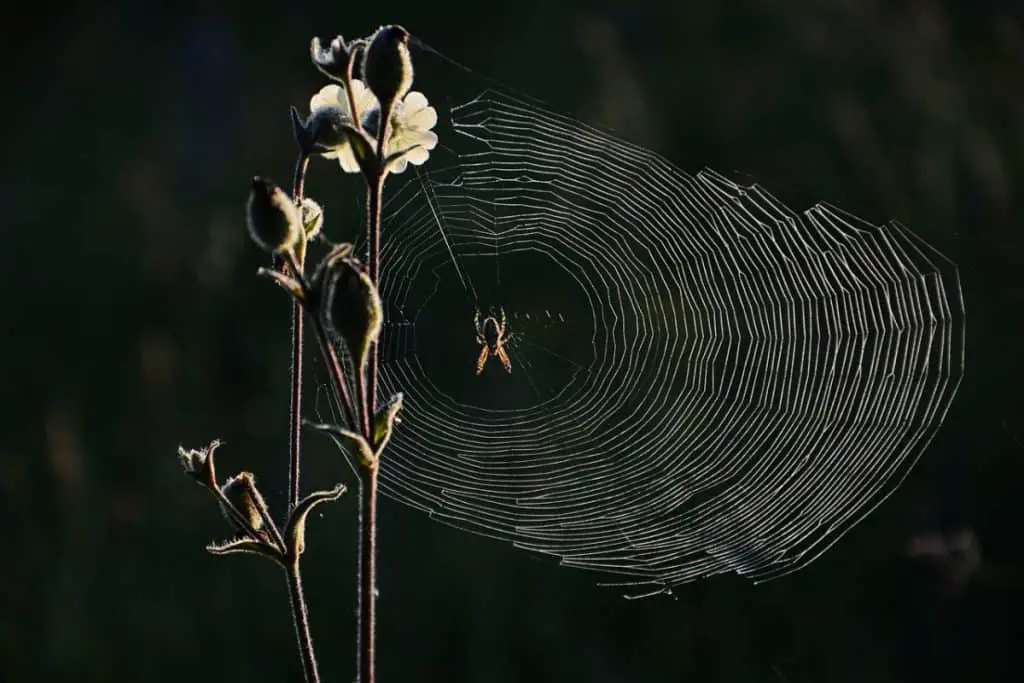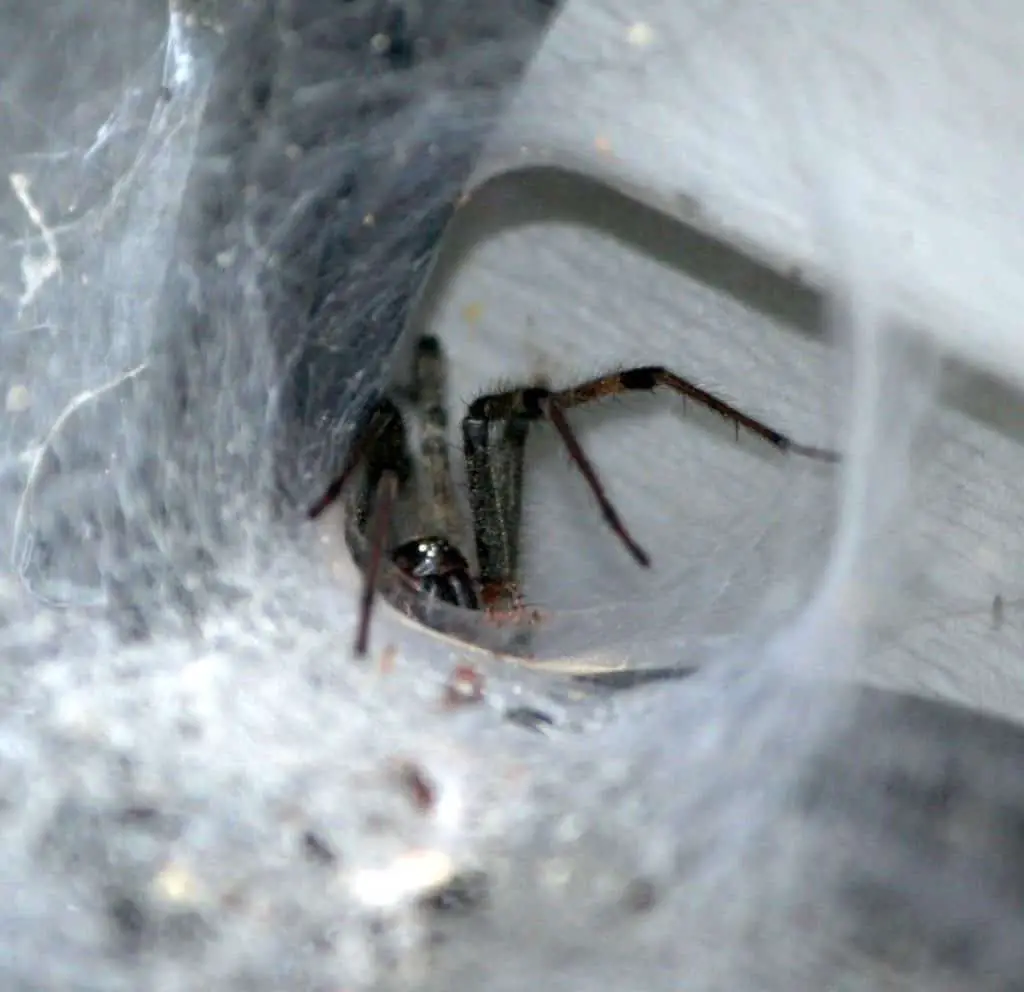Because spider webs vary considerably in design, it is possible, with a little knowledge, to distinguish the webs of different spider families.
With over 50,000 species of spider worldwide there are also many different types of webs that they spin. Some made two-dimensional webs, while other families make three-dimensional webs that look like scaffolding or tubes. Webs are used to catch prey and also to attract a mate.
Spiders use their webs in many different ways, and without their ability to spin webs, their lives would be much more difficult, if not impossible.
Not one species has abandoned silk production and most spiders have many uses for it. These include the building of egg sacs and nursery tents, the emission of gossamer threads for ballooning, and the laying of safety lines. However, the most obvious and significant use is in constructing webs.
The form and strategy of webs vary markedly, reflecting the adaptability shown by the spiders themselves in their wide range of habitats from dunes to lakes and from mines to mountain tops.
Have you ever wondered how spiders attract a mate? Find out about courtship displays here

Evolution of Spider Webs
Since spider webs have no chance of a fossil record, their development through evolution can only be presumed. Early primitive spiders were probably nocturnal hunters preying upon insects that were, at that time (400-350 million years ago), wingless.
Rudimentary webs, which trapped ground-dwelling prey, were probably initially formed by accumulations of draglines that the spiders trailed behind themselves as they moved around.
From these early beginnings, new breeds of spiders evolved which, behaving as trappers, joined the hunters in the competition for insect prey. It is thought that this predation pressure spurred the evolution of insects towards flight as a means of escape.
Unfortunately for the insects, spiders responded by evolving the ability to construct a more advanced orb web. These were placed above the ground catching flying insects.
Simple Webs
A primitive type of web is constructed by the spider Segestria senoculata, a member of the family Dysderidae; it has a cylindrical body and is widespread and particularly common in dry stone walls.
They have a tubular web comprising a concealed retreat with several straight fishing lines radiating from the hole where the spider lurks. These silk lines communicate vibrations from potential prey and indicate the direction of the chase.
If one of the silk threads is gently vibrated, you may succeed in luring the spider into the open.
Found in similar situations, but also common on trees and around houses, are the meshed webs of Amaurobius fenestralis and Amaurobius similis. These thick-set spiders of the family Amaurobiidae have a dark mark at the front of the abdomen and a shiny, black head that contrasts with the rest of the hard outer case.
These meshed webs are much untidier than those of Segestria senoculata, but not only convert vibrations but also serve to tangle the prey’s legs.
If you examine a meshed web under a lens, the network of main threads is surrounded by curly, tangled support threads of silk. The intertwined webs lack the glue which sticks to the prey, but weathers well, lasting a long time before it needs renewing.
Scaffolding Webs
Some spiders make irregular three-dimensional webs. These are characteristic of the families Pholcidae and Theridiidae, whose structures are known as scaffolding webs. You can often find these built in the corners of empty rooms.
The long-bodied cellar spider Pholcus phalangoides is a pale, delicate, and nervous spider. It hangs upside down in its loose web and can be seen to shake rapidly when disturbed, so much that both it and the web blur.
When its prey touches any of the threads attached to the walls or ceiling, the spider doesn’t run towards the victim but instead keeps at a distance. By keeping its distance, it uses its long legs and draws threads from the spinnerets, and throws them over the victim. Only when the prey is securely trussed in silk is the first tentative bite delivered.
The scaffolding web of Steatoda bipunctata, which can be found in most garden sheds, is covered with gluey droplets. Tight, crisscrossing threads stretch above and below a central tangle, under which hangs the rotund, shiny brown spider.
Insects that walk into a thread stick to the sticky droplets and are lifted into the web as the thread contracts. Struggling causes further entrapment in the neighboring threads, and as the spider throws more gummy silk over the victim, it finally injects a potent venom into the prey’s nearest leg. Larger insects like beetles, which might break free by sheer strength, are quickly defeated by the venom.
Some members of the Theridiidae family (tangle web spiders) build a retreat consisting of a long silk tube that hangs downwards in the middle of the web and is heavily camouflaged with plant material.
Do you know why we need spiders? Find out in this article I wrote
House Cobwebs
The unwelcome cobwebs found in many houses are the work of the Tegeneria family (funnel weavers) and are sheet-like, usually with a retreat in a corner.
The brown hairy spiders of this family dart can be seen running in and out of the retreat, running on the surface of the web with an upright stance. These cobwebs are very effective in catching crawling insects, but as they lose their efficiency when covered in dust, new webs are built while the old ones just accumulate dust and dirt in the corners of abandoned rooms and houses.
The more attractive sheet webs are built by the silvery members of the family Linyphiidae (money-spiders). These rather delicate webs are either dome-shaped or look like hammocks, and include hundreds of threads that will entangle their prey.
Feat Of Engineering
The orb web is a two-dimensional structure, unlike sheet webs, scaffolding webs and cobwebs are considered to be the most highly evolved and effective trap as it requires less silk than most other kinds of webs.
However, orb webs weather badly, losing their stickiness and therefore requiring frequent renewal. However, many species are able to roll the web into a ball and eat it, thereby recycling the nutrients.
There are many species of orb-web weavers, including the families Araneidae, Tetragnathidae, and Uloboridae. However, the garden spider Araneus diadematus, recognized by the cross marking on its abdomen, is one of the best known and common.
Other orb-web spiders range from the large and colorful species Araneus quadratus, which can be red, brown, or yellow, to the smaller, bright green Araneus cucurbitinus, which builds its orb web in the curl of a leaf.
An orb web contains between 1000 and 1500 connected points, mostly radii and spiral threads. The number of radii is constant for each species, with the web of the garden spider having 25 to 30 radii, that of Tetragnatha extensa having about 18, and that of Mangora acalypha, between 50 and 60.
Purse Webs
The purse web of Atypus ajfinis is in a class of its own. A tube of silk extends from a burrow in the ground, excavated by the spider in areas of light soil.
This pale greenish species lives inside the tube and, with its huge fangs, bites through the web fabric to transfix any insect on the surface. Slicing a hole sufficiently large to pull the prey through, the spider repairs the damage done to the web later.

Other Webs
In the family Uloboridae, which is more closely related to the meshed web builder (Amaurobiidae) than to the orb-weavers Araneidae and Tetragnathidae, the webs show some unusual features.
The webs of Uloborus walckenaerius are horizontal and comprise 30 to 40 radii. Still, instead of fixing sticky globules to the spiral (as is done by most orb web weavers), the spider spins threads of curly, frizzy silk. Uloborus walckenaerius lacks poison glands so when the prey becomes entangled in the web, it is not bitten but simply immobilized by being wrapped in silk.
Blowing In The Wind
I am sure that you have at some point felt a spider web cross your face as you are walking around.
Most linyphiid spiders, and the spiderlings of some other families, migrate by means of airborne dispersal. They climb onto a high point such as the top of a fence post or a plant and squeeze silk out of their spinnerets, which is blown upwards by air currents and drawn out.
The pull of the silk threads by the wind is strong enough to lift the spiders into the air and carry them away, known as ballooning.
The distances covered by the spiders can be vast, with Charles Darwin recording large numbers of spiders landed on the Beagle while in the South Atlantic.
Interesting webs are built by Episinus angulatus and Episinus truncatus. The type of web built by these spiders is different from the usual scaffolding web, with two vertical threads joined by an H-frame, where the spider hangs.
Sticky droplets at the bottom of each thread stick to insects when touched, and the spider lifts the insects up. Ants, usually rejected by most spiders, appear to be the main prey.

